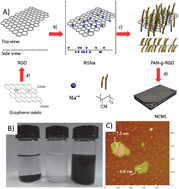Graphene carbanions were prepared and used as initiators for the anionic polymerization of acrylonitrile on a graphene surface. The obtained nanosheets of polyacrylonitrile-grafted reduced graphene oxide (PAN-g-RGO) show high dispersibility in various organic solvents such as dimethylformamide and tetrahydrofuran (∼2 mg mL−1), large aspect ratio, and low thickness, and can be used as precursors for the construction of nitrogen-doped carbon nanosheets (NCNSs). The nitrogen content of the NCNSs can reach up to 11.2 wt% after the thermal treatment of PAN-g-RGO at 600 °C. Remarkably, such NCNSs exhibit a large surface area (∼217 m2 g−1) and outstanding electrochemical performance for the oxygen reduction reaction (n = ∼3.9, JK = ∼21.1 mA cm−2, and half-wave-potential = ∼0.24 V) in 0.1 M KOH. The synthetic strategy described in this work provides a new and easy access to two-dimensional polymer brushes as well as to porous carbon nanosheets with unique functional properties.
